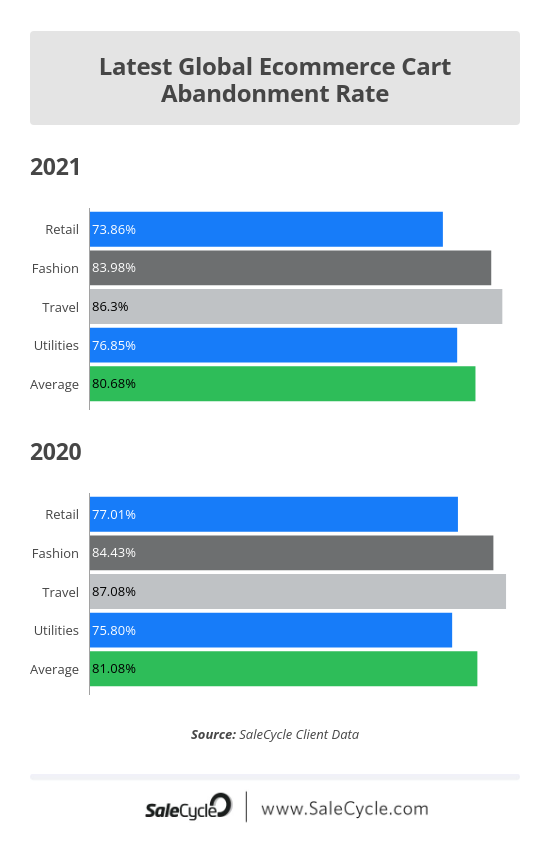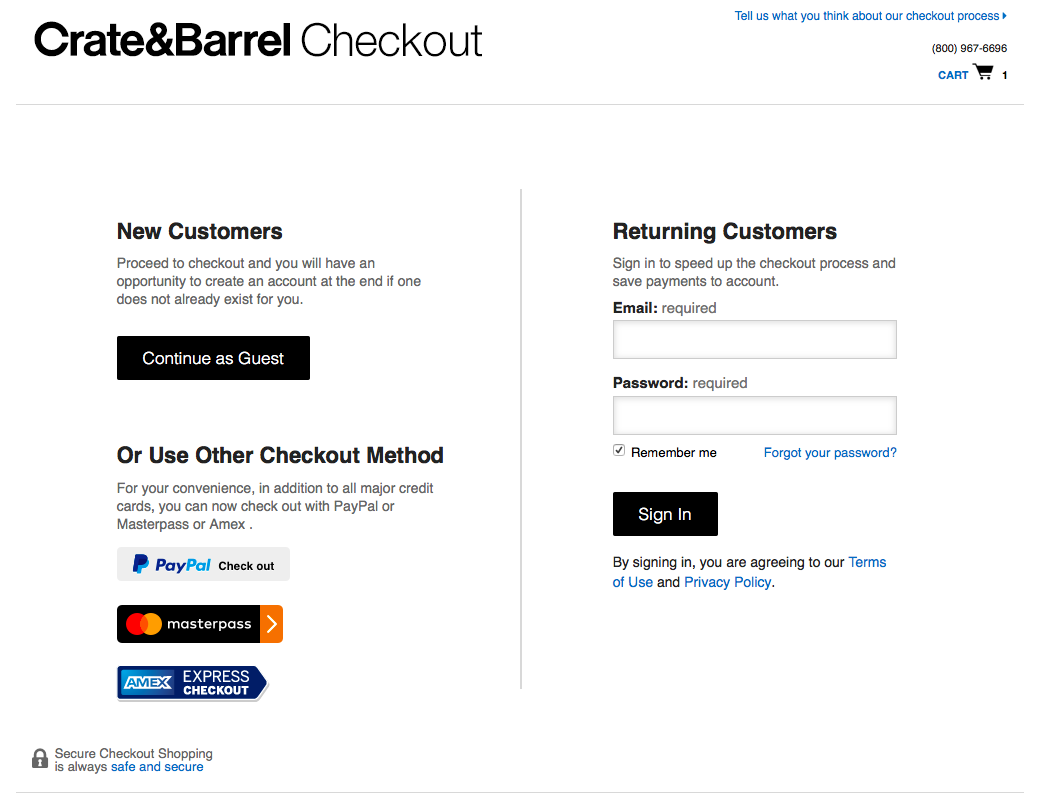Using a range of data, including our own customer surveys, we look into some of the reasons for cart abandonment in the retail sector, and how ecommerce sites can minimize this issue. Of course, SaleCycle also offer conversion rate optimisation services, which can help brands convert more website browsers into buyers.
Here are some of the headline stats from the data:
- 80.68% of retail shoppers abandon purchases after adding items to their cart.
- 34% of shoppers abandon checkout because they are forced to create an account.
- 23% of shoppers abandoned carts due to issues with shipping.
- 18% of shoppers abandon carts because they wanted to compare prices.
Our last 2022 Ecommerce Stats & Trends Report, which covered the average abandonment rate for different industries was 80.68%.


Using cart abandonment surveys, we can identify some of the biggest reasons for cart abandonment. We can then learn how to reduce abandoned carts for our brand.


The single biggest reason is just about typical browsing behavior. People shop around and don’t necessarily buy on the first visit, so there’ll always be some people abandoning because they’re just browsing and aren’t ready to make a decision yet.
A recent survey by Baymard looks more specifically at the reasons for checkout abandonment or browse abandonment. Our stats cover cart abandonment, which means that customers have added items to their shopping carts, but haven’t gone on to buy.
They may have entered checkout before bailing out, but many won’t have made it that far. Brands must also be aware of the busiest shopping months of the year because their abandonment metrics will be impacted by the extra traffic and sales.
The Baymard data below looks at only those who begin checkout before they abandon a purchase.


Why are people abandoning shopping carts, and what can you do about it?
The lessons from the data above is that people are abandoning online purchases due to issues that can be fixed by better design and usability.
Let’s take a closer look at some of the issues…
Experienced a Technical Issue or Error
This covers a range of potential problems with several possible explanations.
For example, a problem completing a form field may seem to be a technical issue with the site, but could just be a result of poor design or copy.
In other cases, sites may slow up or freeze, which can severely dent shoppers’ confidence, especially when this happens on the payment screen.
The answer is to ensure that the site can handle both expected volumes of traffic, and the extra traffic that may come during peak shopping days, Black Friday for instance.
Site performance matters, especially during the checkout process. A slow-loading page, even if it still works, can be enough to put doubts in customers’ minds.
Lack of payment options
It’s important to offer a variety of payment options as well as credit and debit cards for customers who prefer them, and PayPal is the obvious alternative that many retailers now offer.
It could also be about convenience. Even if a customer can use a credit or debit card, the effort involved in inputting numbers (especially on mobile) means some prefer to use other methods.


It’s also important to match the payment methods offered to local preferences. Preferred online payment methods will vary between markets.
While shoppers in the US and UK generally use card payment or PayPal, there is more variation elsewhere.
For example, ELV, a kind of direct debit payment, is the most popular method for German consumers. IDEAL is a similar method which is popular in the Netherlands.


Other options include deferred payment or credit options, which may help with bigger ticket purchases such as electronics and automotive. These can be offered direct by the retailer or via solutions such as Affirm.
Ecommerce sites can’t offer every possible payment option, but by providing choice they can cover most preferences.
Sears does a good job here, with a choice of four different payment options, in addition to its own credit card.


Buying In-Store
If the customer goes on to complete a purchase at a local store, then this isn’t necessarily a problem for the retailer. In fact, it can be an advantage as the store offers opportunities to cross and up-sell to customers.
Ideally, if customers choose to buy in-store, they’ll use click and collect, which provides a link between website and store. It also has the advantage of allowing retailers to match online and offline activity.
Delivery and Returns Policies
Shipping times and costs are a big factor in the purchase decision. The problem is that many sites tend to wait until checkout to reveal the actual shipping costs.
This means that customers are adding items to the basket either to find the actual costs, or are intending to buy but are then deterred by what they see as excessive costs.


A better option would be upfront information on shipping costs on ecommerce product pages (via a zip code calculator perhaps) or cart pages, so customers don’t have any surprises waiting for them during checkout.
The same applies for ecommerce returns policies. Shoppers are more likely to buy with confidence from an ecommerce site which has easier returns policies.


One option for solving both of these issues is clear messaging before checkout on returns and shipping.
It may not be practical for every site, but offers like Nordstrom’s, of free shipping and returns means that shoppers reach checkout without any concerns.

Wanted to Compare Prices
It’s natural that customers will want to make sure they have found the best price for the product, especially for higher priced items.
If your prices are competitive, customers may well return after a quick search, or a cart abandonment email sent soon after may be the prompt they need.
It’s a tricky one for some retailers, as they don’t want to be sucked into a race to the bottom on price which will damage profitability.
Instead, depending on the product, retailer can compete on aspects which improve the customer experience such as next day delivery, great site design or add extra value.
For example, this TV stocked by John Lewis can be found £50 cheaper elsewhere, but not with a five year guarantee:


Some sites have become more creative in their attempts to appeal to comparison shoppers.
For example, Curry’s responds to users copying and pasting the product name to present its price match offering.


Lack of Trust
Trust is vitally important in ecommerce. If people have reason to worry about a site, they simply won’t risk entering their card details.
Whether people will trust your site depends on a number of factors:
- Knowledge of the retailer or brand.
- A professional site design. If it looks like an old geocities site, don’t expect many orders.
- Site performance. Errors and slow loading pages will ring alarm bells.
- Clear contact details and customer service links.
- Social proof – testimonials and reviews from customers. If other customers have bought from the site, this reassures new shoppers.
- Security logos and trust seals. These can be more important for lesser known brands, as they offer reassurance to customers.
Long and Complicated Checkouts
Unless the product being sold is complex, (such as holidays with multiple options on flights, times, extras etc) the checkout process shouldn’t be too hard.
It’s about making it as easy and short for people as possible. This means good clear design, and form fields that are easily understood. If necessary, use copy to explain form fields or deal with possible customer questions, as AO does here about delivery.


Shortcuts which reduce customer effort are also a great way to improve checkout, such as tools which predict customers’ delivery addresses as they type.


Some alternative payment methods have the added bonus of speeding up checkout for users.
With saved payment and shipping details, options like PayPal, Amazon Checkout and Visa Checkout mean that customers can just enter a username and password and avoid 90% of the form filling.
It can be even simpler on mobile too, thanks to methods like Google and Apple Pay.


Having to Register Before Checkout
Checkout registration adds another step to the process of buying, and has been shown to be a barrier to purchase.
It creates extra work for shoppers, which is why guest checkout is a better option. People can still create an account later, but it avoids making it a barrier.
A guest checkout option allows customers to enter an email address and head straight to checkout. It means customers start to complete address and payment details more quickly and makes the process seem like less work.
Some sites (Bellroy is one example) send customers straight into checkout forms from the shopping cart page, but a more common approach is to offer the option of guest checkout, login, or registration.
Some, like Crate&Barrel, don’t even offer registration, instead telling new customers that they can create an account later if they wish.


Just Looking
Some people just aren’t ready to buy. Perhaps they’re adding items to carts to check the total price, or using the cart as a wish list.
Depending on the product, the research process can take some time. A big purchase like a new PC or TV is likely to involve some consideration, more so for other products. The average holiday purchase process is said to last 45 days, while for automotive it may be even longer.
Sites can at least help shoppers with the research process, which keeps them on site (and the brand in shopper’s minds) longer.
Product ratings and reviews can help here. Reviews like these on Home Depot are great for helping customers research, presenting unbiased information on product performance and features.


Speak to an expert
Learn how to convert your online audience into revenue with our experts.
Graham Charlton
Graham Charlton is Editor in Chief at SaleCycle. He's been covering ecommerce and digital marketing for more than a decade, having previously written reports and articles for Econsultancy. ClickZ, Search Engine Watch and more.








![Valentine’s Day Ecommerce Tips and Trends [2024 Strategy]](https://www.salecycle.com/wp-content/uploads/2019/01/valentines-ecommerce-1.png)




![How SaleCycle helped Vodafone increase their online sales by an additional 2,000 additional sales per month [Extended Version]](https://www.salecycle.com/wp-content/uploads/2023/08/vodafone-banner.webp)




